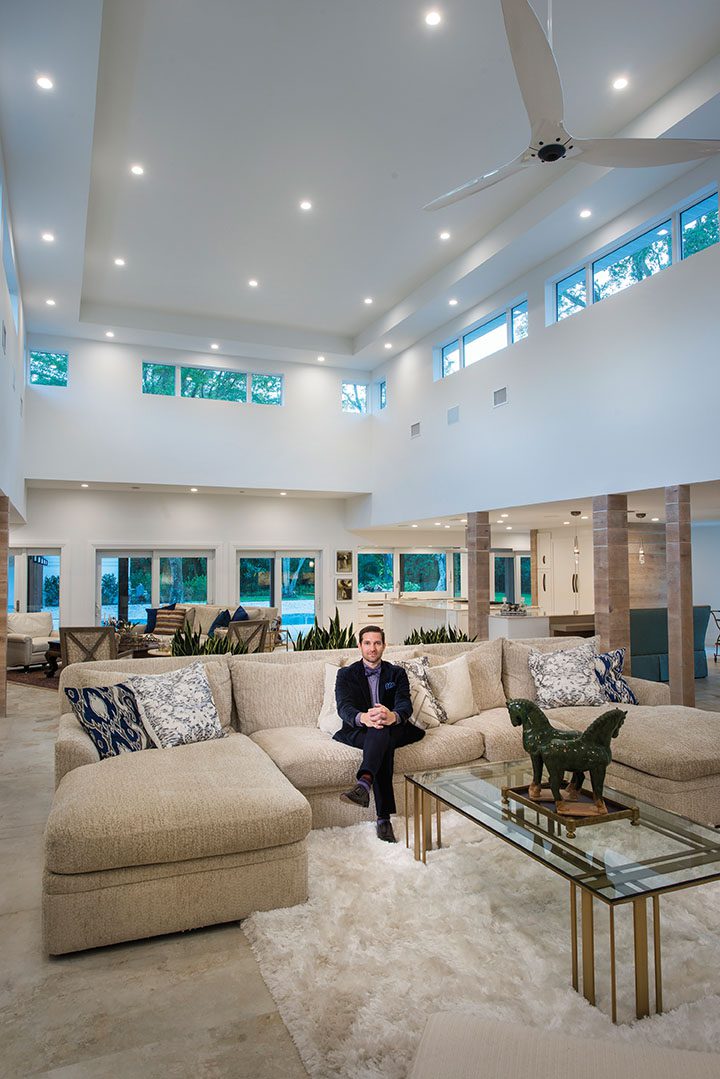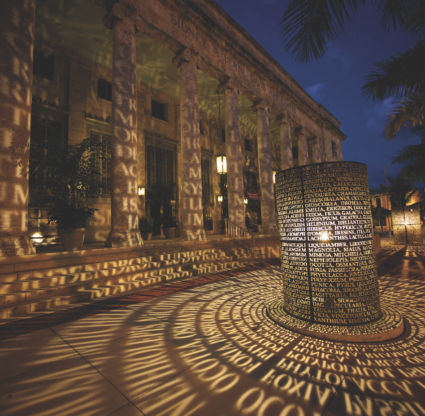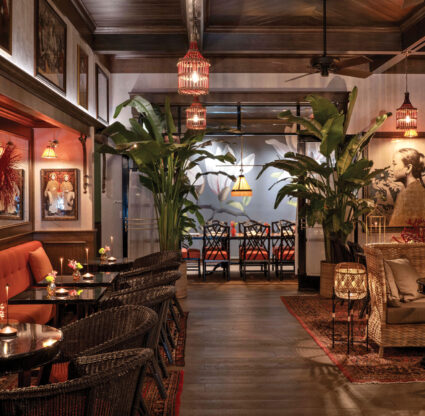Some people have taste that’s been nurtured organically. It comes from years of thoughtful editing of the world around them. They don’t pick art because it fits above the sofa and they don’t pick sofas to fit their Degas. They seem to have left the gate fully formed with the talent required to make an impact on their surroundings.
But based on what is surely one of the swerviest (might be a word) career paths imaginable, you wouldn’t have necessarily expected that from Dwayne Bergmann of Dwayne Bergmann Interiors in Fort Myers. Yes, he grew up in Paris, Missouri, to a family of professional custom homebuilders. That certainly gave him a leg up. But he spent the majority of his youth riding and showing horses. In fact, during his second year at the University of Missouri (on a full academic scholarship), he decided he wanted to pursue riding full time—so he moved to Ocala and started showing at the professional level. Within two years of turning pro he had two national titles and two world championships to his name. Then he promptly realized he didn’t want to do that for the next 40 years.
An acquaintance moved to Fort Myers in 2000 and Bergmann followed, taking a job with PC Management and finishing his degree. Within a few years, he was spotted and hired by Home Depot (and later at its HD Supply division) as a regional director. He was on the corporate fast track, working for the retail giant from 2006 to 2013 and traveling from coast to coast as a human resources executive. But when he was offered a high-level promotion, he did what most creatives do: quit. He founded Dwayne Bergmann Interiors in January of 2013.
Of course, from 2000 to 2013 he was freelance designing, and doing 10 of his own homes that he would sell (furnished) before moving on to the next. In the meantime he would do designs for friends and family. He also designed a line of handbags that was eventually sold to Michael Kors. So maybe it isn’t that far-fetched that he is now one of Southwest Florida’s most celebrated interior designers. His creativity needs an outlet.
We thought it might be nice to get inside the mind of an interior designer who’s making our region better-looking, one house at a time. Maybe we’ll learn just enough to know how to get our homes “magazine-ready.” We caught up with the 39-year-old Bergmann at his Brynwood showcase home in Fort Myers that he bought two years ago as a fixer-upper. Or as he might call it, a design exercise.
 |
|
The main living room of the Brynwood estate was once low and dark. Bergmann literally raised the roof to create a large, contemporary, bright space. |
Gulfshore Life: Why buy this house?
Dwayne Bergmann: This is a complete way of reimagining a space. People said when they first walked in here (before the renovation), “You’re never going to be able to lighten it up.” Those same people have come in and said, “I could never have imagined that you could get this much light.” I wanted to show how to overcome some of those challenges. For example: the ceiling heights. They were way too low. We raised them nowhere else (other than the great room) but we used the continuity of the color palette and we used it to stretch your eye where we needed to. I specifically kept my (stainless) banding (on the interior wood-clad columns) to connect to the outside. We could have taken it down, but little subtleties like that make a big difference.
GL: Is it safe to say this house was a personal challenge?
DB: I looked at it as though I was going through a professional program: How can you turn a house around? What can you learn from a massive project? (But) I never anticipated how much it would cost. I mean, we did a budget, but with this renovation there were so many unknowns. I’ve done these for myself before, but not on this magnitude (a complete overhaul, take the roof off and lift it for both the house and the garage, etc.). In Naples when they knock a place down and you say to yourself, “Geez, that was a perfectly fine house and they demolish it?” It makes perfect sense now. It’s the very first thing I would have done now. We could have built this exact same (finished) house from a set of plans faster and cheaper. It’s sad. You pay twice for everything. You pay to take it apart … and then you pay to put it back together. (It ended costing approximately $250,000 just to raise the roof.) My current take is if you’re going to touch more than 15 to 20 percent of the roof and you’re not just replacing—just knock the house down.
 |
|
Columns wrapped in French oak with stainless steel seams mimic exterior details. |
GL: What inspires you?
DB: I am not a fashionista, but I appreciate fashion. And my design aesthetic and my creativity is very motivated by fashion. So I definitely watch what’s happening in the fashion industry, (especially) in the European market. They are two years ahead. … I could walk you through several of my design (projects) and give you their fashion profiles: what helped me establish the color palette, the thought process, why I chose this accessory or that color.
GL: So what was your fashion inspiration for this particular house?
DB: As shown, this house has Calvin Klein/Ralph Lauren aesthetics. Those would be two fashion designers who influence my thinking. Calvin Klein usually showcases more of the cool neutrals, but it's very simplistic. Even Calvin Klein Home is influenced a lot by whites and a couple of touches (of neutrals). … So you take that aesthetic that can be a little too modern and a little too minimalist and then combine it with the very homey kind of traditional classic twist of Ralph Lauren. For me that is what happened here. I get those twists along with my Frank Lloyd Wright meets Old Florida ala Dwayne Bergmann style.
GL: But how do you go from a low, dark, average house (as it was previously) to a tall, light, beautiful house? Where did that inspiration come from?
DB: The answer is I don’t know where it comes from. I just don’t. I can tell you my process. I have to be in a space. … I get a feeling from every space I go into. It can be light, dark, energetic, lacking of energy. And again, from someone with an MBA and a business background, and I’ve always made my decisions based on black and white numbers, so this is the weirdest thing that I say to myself, “OK, I’m going to get a feeling for a design and then I’m going to follow that feeling through various decision points.” It is the most artistic thing that I’ve ever been involved with personally. It just comes down to I can feel a design.
GL: So if your car were to break down on the side of the road and you walked into someone’s house, will you go all designer on them when you walk through the door?
DB: Some designers are very judgmental. I don't go to a place and immediately start picking it apart. … I think if I were immediately to go in and say what I thought, I would miss hearing from my client what they want. I would rather understand more value-based components of the client’s needs. What’s important to them? What do they like about their house? What do they not like about their house? What are they looking to change? Is there a feeling that they’re looking to have? Then I will really start looking around to see.
 |
|
The sitting area just off the pool showcases Bergmann’s ability to mix and match. |
GL: Talk a bit about how you chose the color palette for this place.
DB: I found the floor first. I knew I wanted earthy, organic, light material, so that put me in a light color palette—my brain kind of works in cold neutrals and warm neutrals—and then from there I break it off into primary and secondary colors. And the same for textures—warmer, cooler, light reflection. The (floor) is 4-foot-by-4-foot porcelain. It’s very rare and this is a new product. The pattern is the floor of an Italian artist that they photographed and then reproduced on the tile. In the kitchen I used Calcutta Pearl. It’s where onyx turns into marble. It has some translucent qualities to it.
GL: It seems like it would be easy to go over the top in a place like this.
DB: For this particular house, it’s about editing. I think that’s what makes it beautiful. It’s simple and elegant. The finishes have a similar tone or design element. And where I do have a different finish or texture, I repeat it several times. I only have three primary finishes in the entire house: the tiles on the floor, the wood element (on the columns and in the wine room) and the (Calcutta Pearl) here in the kitchen. I kept saying to myself, “Don't add. Don't add.”
 |
|
The dining room features a one-of-a-kind table designed by Bergmann that utilizes acrylic and Civil War-era cherry that weighs 800 pounds. |
GL: I just noticed that table in the dining room—it’s amazing.
DB: So that is my very first original design piece of furniture. This is a kind of neat story. I was walking through this exotic hardwood place out in Alva and was looking for material to build something else. I saw this rough-hewn piece lying against the side of his barn and I asked him about it. He sighed and told me that he had a guy in Naples ask him for years to get a piece of cherry this size. What happened is that all the cherry trees in the south were burned during the Civil War, so if cherry is larger than 18 inches or so wide, you know it had been cut before the Civil War. … Well, the guy from Naples never called him back and so I ended up buying it. Then I thought, “What the hell am I going to do with this huge piece of cherry?” … I wanted to preserve it in a contemporary setting, so we came up with this design where it’s floated between acrylic legs and has a touch of industrial with the stainless steel plates. I’m really happy with this piece. … But this year we will have four more pieces coming out including two chairs and a bar-in-a-box (on which he collaborated with artist Veron Ennis).
GL: What is the Dwayne Bergmann style?
DB: Thoughtful. A detailed approach. Orderly. I prefer order over chaos. I’m not likely to just throw things on a wall randomly. I prefer clean lines. But that doesn’t mean I don’t like curves or arches. And multiple textures. We live in a 3-D world. I like seeing textures together. The more senses you evoke, the more representative that home is. It’s always about a feeling that we’re creating. I use textures to push that sensory direction one way or another. And there has to be something unexpected.
 |
|
The master bathroom is over-the-top minimalism featuring Calcutta marble throughout and textured plaster walls. |
GL: So there is no guttural reaction when you walk through a door?
DB: Now, with that said, I am extremely, extremely, impacted by my visual surroundings. I know if I want to be in a place or leave a place. That is immediate and I can’t change that. … We had the chance to go to Cuba a few years ago and it was the weirdest emotional experience for me because on the one side it was so stimulating because of all these buildings and the architecture and the opulence that once existed, and on the other side it was so depressing. And everybody kind of says that, but it was visually depressing for me because how could you let this beauty deteriorate? I just don't really want to go back. It’s crumbling. It deserves to be preserved. I have a need to make the surroundings visually appealing. That is a need on my part.
GL: Don't people just assume that interior designers are going to cost a fortune?
DB: I’m adamant about the fact that we don’t cost clients more money at the end of the day. This is coming from someone who would have previously struggled to hire a designer. I have hired designers myself before we opened this business, and my experience was better; the outcome was better. I didn't hire them because I didn’t have a vision. But because they were able to execute it and have the professional contacts to put it together. And when I listened to them I got a great product. This is a way to enhance your end result. It’s not a line-item cost. If you really look at end result, what did it cost? What did you have to get right the first time that you might not have gotten right? What is the overall value of your house versus what it was before? And then, even selling your house—how quickly did it sell versus staying on the market because it was well-thought-out. It was set up or staged properly. All of those things should be considered when debating hiring an interior designer. I think we get a little bit of pushback because we bring the numbers to reality. … It’s like saying I want to go into this house and have a complete wardrobe available. If you knew how much your wardrobe cost versus walking into a house with no wardrobe … you would blink your eyes five times and say, “Oh my goodness I had no idea I spent that much on shoes.” Well, that’s what we’re doing in most houses. We’re taking a blank house and giving you a full wardrobe finished.
 |
|
The Tang Dynasty Terracotta horse replicas with crackled glaze finish symbolize a strong and powerful family unit. |
GL: But you were your own client on this project. How does it work when other people hire you?
DB: It’s hard when people aren’t real with us. We need their real, authentic selves. When we get that feedback, it becomes a really big percentage of the feeling for the design. But with this project, that I want other people to see, there was like this big ambiguous client that I developed in my mind. I wanted to introduce something that would be appealing for people who enjoy architecture and design and living on the West Coast of the U.S., because I think it has a little bit more of that feeling. It’s just a little bit different for Fort Myers.
GL: If we hired you, what would we get? Sketches? Computer simulations?
DB: I love to sketch but it just doesn't make sense time-wise. What I charge for my time versus what it costs for a CAD programmer or a junior designer means your money can be put to better use. We use a program called Chief Architect and we can move furniture and paint walls and turn things from glass to wood, etc.
GL: So clients aren’t the biggest challenge?
DB: I’ve talked to a lot of very successful designers who have a lot more demand than we do in Southwest Florida, and there is a very consistent theme: pick your client. Make sure that the two of you are going to be able to work together. Remember, we work together longer than some people date. A lot of time, when we are doing a full house, the construction build-out is 12 to 18 months. You’re going to have six months to a year of preplanning. So we’re talking a two- to three-year relationship.
 |
|
The exterior of the Brynwood estate features newly raised roofs on both the main house and the garage. |
GL: Is there one trend currently that you really don’t like?
DB: There are a couple of things that I’m on the fence with. Like the brass champagne (finishes). We need to either get all in or get out. I like it, so it’s not the worst trend, but we are missing components for it to be effective. Our plumbing fixtures and our hardware companies are not on board. They’re not making anything that allows us to make a thoughtful design. So it’s been challenging to mix these metals. And I hate the trend of printing graphics on everything. All of these companies are doing pillow fabrics, lampshades, tabletops … everything is some random print—from pop art to some cheap image of a cityscape—it’s on everything. And I hate this rustic furniture thing. If it’s nailed together and it has a rough edge and you see the nails and screws then it’s cool? … Chinese workers must think we all live in barns.
GL: What are the challenges people don’t recognize with interior designers?
DB: I think the struggle in this profession is the dependencies. We are so dependent on another whole group of professionals to execute what we have planned. … We try to be very specific about what we want, but it’s not like an artist who can just say, “Ugh, well that color didn’t turn out the way I wanted it to. Lets just wipe it off and start again,” because there are monetary ramifications for us. You can’t pay $10,000 to have a wall painted, but then it’s three shades off. You can’t just go back and say, “Well, I need another $10,000 for this mistake.” So it adds pressure. And in any creative endeavor, the more pressure you add, the tougher it gets.





